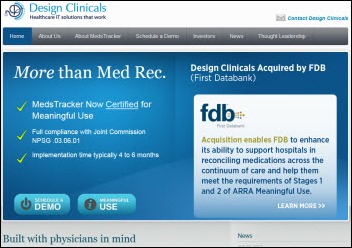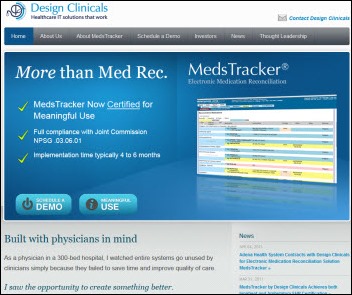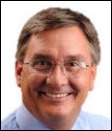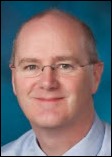Robert E. Watson is president and CEO of Streamline Health of Atlanta, GA.

Tell me about yourself and the company.
Streamline was founded in 1989 and went public in 1996. The fundamentals of the business are really about capturing the unstructured data around the patient care experience, integrating that information with the record, providing a series of workflow solutions around coding, clinical documentation improvement, and analytics to improve financial outcomes.
I’ve been in healthcare for 30 years, originally as an investment banker, unfortunately. It seems like I have to apologize for that. I’d been the founder and CFO of a company in the ambulatory surgical center business that we took public in the 1980s and sold that business to HCA. I’ve spent the last 13 years in the healthcare technology space.
Speaking about unstructured data in general, what’s new in that area, and how is the co-existence with EMRs going?
What people find when they deploy a record — and we hear this all the time — is that there’s an abundance of information that’s outside of the core record. Most of it’s unstructured. Historically, it had been paper.
Today, if we look at our own business, the percentage of that unstructured data that’s paper is dropping into the mid-80s. You’re seeing things like images that don’t for some reason interface with the RIS or PACS, .WAV transcription files, and other pieces of information that are important for the quality of patient care. Also important, frankly, to the financial outcomes. You have to get that information in order.
Are hospitals, even those that claim to be paperless, still getting a lot of external information from places that aren’t?
Yes. There is tremendous amounts of information that comes in externally. We have a client in metropolitan New York that 95 percent of the inbound physician order referrals for surgical events come in via fax. I don’t foresee that changing in the near term.
There was some enthusiasm for the hybrid EMR, which made the best use of paper records moved to an electronic form such as scanned images. What can people do with information in your system that they can’t do with paper?
It depends on the construct on how you get that information and unstructured data into the EMR. At the very basic, you can view that information inside the EMR. For example, if you’re in an Epic facility and there are prior visits, those prior visits may have been outside of the electronic version of Epic that’s in place. You can click on a tab and look at the PDF of those versions.
Where we’re seeing the market got today is a much broader use of OCR technologies and other ways to make that unstructured data actually actionable inside the record. We see it as taking unstructured data and turning it into knowledge to help not only clinicians, also but the financial side of the provider to make better decisions.
The criticism of scanned text documents is that nobody’s ever going to look through a bunch of PDF files. Is the OCR technology and your ability to build that into the workflow changing the usefulness of that data that previously nobody would have even looked at?
We’d like to think so. It has to. There are pieces of information that exist outside that core record that are important to the quality of the care of that patient.
I realized clinicians are pressed for time, but there’s information that’s critical. You want to make sure they have it in a form that’s actionable. If you can search it and deliver that information to them at the point of care, you’ve made a big advancement over simply viewing a PDF where you’ve got to read it and look for the pieces of information.
Much of the agenda of both providers and vendors has involved chasing after the Meaningful Use requirements. Are those having an effect on your business?
It has. Less so in Stage 1 than as we start looking in Stage 2. There are parts of the Stage 2 process that the things that we happen to do at Streamline would give them proof points to get their payments along those lines. For example, release of information, a very critical part. Historically, as you and most of your readers probably know, a lot of the release of information processes have been outsourced. Some of the vendors like ourselves have built that release of information process into the technology that we sell.
The acquisition you did in 2011 of Interpoint Partners to create the OpportunityAnyWare product changed the company’s footprint drastically, along with the Meta Health acquisition. How do you think the analytics market looks and who do you compete with most often?
That acquisition of Interpoint was transformational for Streamline. We would not be where we are today had we not been fortunate enough to be able to complete that transaction, and for a variety of reasons.
But fundamentally, if we think about the analytics space today, if you were at HFMA a few weeks ago at the ANI meeting in Orlando, every other booth had big data or analytics, probably every booth actually. It’s a realization in the marketplace that there is an abundance of information that’s generally available — in EMR systems, in the claims systems, in the billing systems, in the coding systems — that has not historically been used to the best advantage of the payers, the providers, or frankly even the patients. I think that gets lost in this, by the way.
We see analytics as the cornerstone of everything we’re going to do at Streamline. But more importantly, the market itself in general has realized that there is great information that sits in these systems. We need to get it out and we need to get it in form that is actionable. It’s one thing to present a KPI dashboard. It’s another thing to give someone actionable information. We think that’s a key part of what we’re trying to do.
Competitively, it’s the usual cast of characters you’d expect us to be competing against – The Advisory Board, MedAssets, MedeAnalytics.
I think I heard you say that the benefit to patients is often lost and the marketing is aimed at hospitals trying to get control of their physicians. Is there enough emphasis on what the individual patient can immediately get out from all that data?
Do I think there’s enough emphasis on the patient side of it? No, absolutely not. I think it’s going to take a long time to get there.
The financial challenges and operational challenges that providers face today are staggering and they’re only going to get worse. The first step in the lifecycle of analytics is to address the financial and operational components of the enterprises. Along the way, what comes out of that is an understanding that there is an enormous amount of rich clinical data that can have an impact on the patient either at the point of care or post-care. If you’re able to provide a patient with positive information that’s going to help them once they’re discharged — that prevents readmissions, for example — that’s a piece of information that we should get in the patient’s hand. Or just helping the hospitals understand their patients better.
For example, if you have 70-year-old patient taking 12 different medications, lives in a third-floor walk-up in the Bronx, and has mobility issues, do you think that patient is going to actually get those scripts filled? Pulling that kind of patient information out and being able to present that in format that the care management team can say, this patient is likely to be readmitted because they’re not going to fill their medications — what do we do as part of the care management plan to make sure that he or she gets those medications? That’s the patient part I’m talking about.
It sounds like what you’re saying in terms of who is looking at analytics is that there may be some desperation involved. Hospitals are trying to save the ship financially and desperately trying to find tools that can help do that. Do you sense that hospitals need a solution that they can’t necessarily define because they are facing the uncertainty and aren’t really sure how to react to it?
Yes. They can’t define what it is that they want when it comes to analytics. That’s why you see so many vendors saying, “We’re the next generation in analytics vendors. We can help solve all your financial problems.”
The reality is I don’t think anybody has cracked the crystal ball of what’s the right amount of information and how to deliver and how to make it actionable for our clients. None of the vendors have. But I think we all have the right intention in mind, which is to ensure that our clients are getting meaningful, positive return on investment that’s ultimately going to translate into that provider IDN’s ability to provide quality care in the community. We have to keep the hospitals alive.
I was looking at the STRM stock chart today and noticed that the share price has gone from in the $1.50 range in early 2012 around to $7 today. Do you think that the industry, in all its excitement about the bigger and better-known companies, has missed a pretty big success story?
Streamline flew under the radar for a long time. Over the last couple of years — really starting last May – the investor marketplace started to pay attention to what we were trying to assemble here, I think. A lot of investment dollars chased the big EMR vendors. Look at Cerner’s stock charts or anybody else – they’ve all done fairly well in this period, for the most part.
At $1.50 per share, our market cap was about $16 million. It’s hard to find institutional investors, but lot of retail people want to own that kind of stock where we trade by appointment. I think in 2010 we were trading 5,000 or 6,000 shares a day.
We’ve invested a considerable amount of effort in telling our story to the marketplace and it has responded favorably. Frankly, our team here has performed very well. Our sales organization delivered, our operational teams delivered, the technology folks delivered. We’re getting a little better recognition in the marketplace at the moment.
My first reaction to the market cap was the value of being publicly traded is marginal compared to the expense and headaches involved, but it was a lot worse when the market cap was smaller. Will you be able to grow better at this point because you’re publicly traded?
I don’t think there’s a person on the face of the earth that wakes up one day and says, you know, I want to be CEO of a microcap public company, so I can assure you I did not.
That being said, our current position being public offers us some advantages. The obvious one, you have better access to capital and the capital markets, but beyond that, the cost of being public is still quite burdensome. It was clearly excessively burdensome when we were a $50 million market cap company.
You used the term a couple of minutes ago that investors were responding to what you are trying to assemble. The two acquisitions made the company a lot more attractive in different ways. Do you see that the company’s growth will be based on further diversification or acquisition?
We gave our guidance to the analysts earlier this year. Our growth guidance in terms of revenue and Adjusted EBIDTA were entirely based upon organic growth. We think we’ve assembled a set of assets today where there’s inherent meaningful organic growth in an orderly fashion and have really focused our teams on that.
That said, when I get asked the acquisition question in every earnings call, I try to give the same answer. One of the things we’ve tried to create culturally here is building deep, meaningful relationships with our clients. Those relationships give us ideas and point us in directions of where our clients think there are either weaknesses in other vendors or challenges they don’t see being met by their current set of vendors, where they come to us and said, hey, can you do anything along these lines? Have you thought about being in this business? So when we think about the potential to do additional inorganic growth opportunities, that thought process is really frankly driven by our relationships with our clients.
What’s your plan for the company over the next five years?
When we came here in early 2011, we had a vastly different plan than the plan we have today. Plans are iterative, as you’d expect. The original plan was, let’s try to stop the cash losses and grow the business modestly.
In early to mid-2011, we went back to the board of directors and said, we think there’s an opportunity for a mercurial growth here. We want to set out a plan where we put forth a five-year strategic plan, which we redesigned again this year to take another look at the next rolling five years now that we’ve been here but little over two years. We think we have meaningful runway in front of us, an opportunity to build something that’s exciting. We’ve been able to culturally create an environment where our clients understand our commitments.
One of the things we use internally culturally is something called the three Rs, which is respect, responsibility, and results. The cornerstone of those three R’s is building those relationships with those clients. We think those client relationships put us in a position to grow a meaningful business over the next four to five years.
Our current five-year plan starts every morning when I get up. It’s the first day of that five-year plan.
Do you have any concluding thoughts?
First, thank you very much for thinking of Streamline. We’ve flown under the radar for 20-plus years, so I appreciate the opportunity to tell a little bit of our story.
Secondly — and I think this is an important generic comment about this space — as we all know, we’re entering another series of challenges for the whole healthcare ecosystem. The one question that we all need to ask ourselves is, what can we do to ensure that we have a healthy healthcare system for the generations that follow us?
I think that’s really an important question. Every day we challenge our associates to think about what can we do to make sure that the health system survives all the challenges that are in front.
Thanks again for thinking of us and our team here at Streamline.


























































































It doesn't look like much more than a computer facing a wall!!